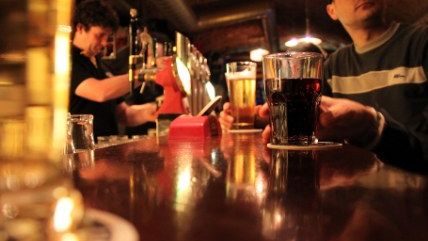Restrictions on Adult Alcohol Access Don't Make Us Safer
Data show rules don't appear to reduce violent crime, binge drinking, or drunken driving.


Violent crime and binge drinking are two potential undesirable outcomes of access to alcohol. But is increased access to alcohol for adult drinkers a sufficient precondition for these attendant negative externalities of drinking?
A recent look at the impact of changes to laws governing pub hours in England and Wales 10 years ago, reports the BBC News Magazine, suggests that it is not.
In 2005, the new Licensing Act meant that pubs, which had been forced by law to close at 11 p.m., could stay open all day, every day.
Predictably, opponents of this deregulation outlined end-of-days scenarios resulting from a 24/7 drinking culture.
"It was reported that the act would lead to round-the-clock drinking and there were warnings that extended hours would cause chaos," reads the BBC report. "The Royal College of Physicians said it would increase alcohol consumption. Police chiefs complained that their forces would be stretched. One judge said that easy access to alcohol was breeding 'urban savages.'"
But data show that violent crime—already falling before the Licensing Act—has continued to plummet since the law took effect. The same is true of rates of dangerous binge drinking.
While the Act may or may not be responsible for the decline, predictions that it would increase rates of negative unintended consequences have proven unfounded. A new wave of "urban savages" failed to materialize.
In the United States, policies like those that existed in England and Wales before 2005 are common. Indiana, for example, prohibits any sales of alcohol between 3 a.m. and 7 a.m.
A tangled web of other restrictions also exists.
For example, Massachusetts has prohibited bars and restaurants from offering happy hour drink discounts since the early 1980s. The ban arose after a woman jumped onto the hood of a friend's moving car, fell off, and died. The driver had been served several discounted drinks during a happy hour.
"State officials concerned about drunk driving" soon proposed to ban happy hours altogether, reported the Associated Press.
How is the ban working? CDC data show Massachusetts today has the second-highest rate of drunk driving in New England, and a rate that's 15 percent higher than the national average. This is true despite the happy hour ban and the fact the state has the most robust public transit system in the region.
While happy hour bans are uncommon elsewhere in the United States, other limitations on adult access to alcohol are not. Dry counties and restrictions on Sunday alcohol sales exist in many states.
While restrictions like these haven't produced benefits, that hasn't stopped a host of groups around the country from pushing for still more curbs on alcohol access.
In California, the neo-Prohibitionist group Alcohol Justice fought against a new state law that opened up wine tastings at farmers markets. As I discussed here earlier this year, the group argued that such tastings "threaten public health and safety."
Elsewhere, the University of Wisconsin Law School is home to an anti-alcohol center, the Wisconsin Alcohol Policy Project, that seeks "to improve the alcohol environment." Improving that environment, according to WAPP, means influencing "municipal leaders, law enforcement, the media and community coalitions" to adopt "[p]ublic policies [that] make… alcohol less available… less attractive [and] less affordable."
As data from England, Wales, Massachusetts, and elsewhere shows, policies like these that restrict adult access to alcohol don't reduce binge drinking and violent crime. They don't appear to reduce drunk driving, either. Supporters of such policies must come to term with these facts.
Finally, we know already that the solution many propose is itself one of the greatest—if not the greatest—causes of the problem it's intended to rectify. Violent crime and binge drinking were the top negative unintended consequences of alcohol Prohibition in the United States in the 1920s and early 1930s.
Punishing drunk drivers and those who perpetrate violent crimes (whether while drunk or sober) and educating the public about the dangers of binge drinking are sound public policies. On the other hand, restricting adult access to alcohol is a farcical and failed policy.


Show Comments (18)